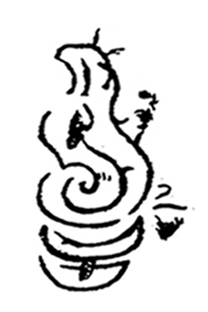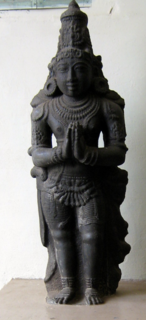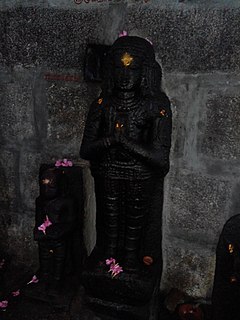
The Pandya dynasty, also referred to as the Pandyas of Madurai, was an ancient dynasty of South India, and among the three great kingdoms of Tamilakam, the other two being the Cholas and the Cheras. Extant since at least the 4th to 3rd centuries BCE, the dynasty passed through two periods of imperial dominance, the 6th to 10th centuries CE, and under the 'Later Pandyas'. The Pandyas ruled extensive territories, at times including regions of present-day South India and northern Sri Lanka through vassal states subject to Madurai.

Venad was a medieval kingdom lying between the Western Ghat mountains and the Arabian Sea on the south-western tip of India with its headquarters at the port city of Kollam/Quilon. It was one of the major principalities of Kerala, along with kingdoms of Kannur (Kolathunadu), Kozhikode (Nediyiruppu), and Kochi (Perumpadappu) in medieval and early modern period.

Pandya Nadu or Pandi Nadu is a geographical region comprising the southern part of the present day state of Tamil Nadu. The region is bounded on its West by the Venad/Ay Nadu, Northeast by the Chola Nadu and Northwest by the Kongu Nadu. It comprises the present-day districts of Madurai, Theni, Sivaganga, Ramanathapuram, Virudhunagar, Tirunelveli, Tenkasi, Thoothukudi, Kanniyakumari, parts of Pudukkottai and Dindigul.

The Chola Dynasty was a Tamil thalassocratic empire of southern India, one of the longest-ruling dynasties in world history. The earliest datable references to the Chola are in inscriptions from the 3rd century BCE left by Ashoka, of the Maurya Empire. As one of the Three Crowned Kings of Tamilakam, along with the Chera and Pandya, the dynasty continued to govern over varying territory until the 13th century CE. Despite these ancient origins, the period when it is appropriate to speak of a "Chola Empire" only begins with the medieval Cholas in the mid-9th century CE.

Parantaka Chola I was a Chola emperor who ruled for forty-eight years, annexing Pandya by defeating Rajasimhan II. The best part of his reign was marked by increasing success and prosperity.

Parantaka Chola II was a Chola emperor. He is also known as Sundara Chola as he was considered an epitome of male beauty. He was the son of Arinjaya Chola and Kalyani, a princess from the clan of Vaidumbas, an Andhra dynasty based in Kurnool and Kadapa districts. Parantaka II ascended the Chola throne despite the fact that his cousin Uttama Chola, the son of Gandaraditya was alive and he had equal if not more claim to the Chola throne.

The Later Chola dynasty ruled the Chola Empire from 1070 C.E. until the demise of the empire in 1279 C. E. This dynasty was the product of decades of alliances based on marriages between the Cholas and the Eastern Chalukyas based in Vengi, and produced some of the greatest Chola emperors such as Kulothunga Chola I. Even though the later Cholas are often referred to as Chalukya Cholas, there were two breaks in the line. Kulothunga Chola II and Rajadhiraja Chola II did not belong to the Chalukya Chola line. Kulottunga II was a grandson of Vikrama Chola and Rajadhiraja Chola II was not the son of Rajaraja Chola II.

Rajaraja II was a chola emperor who reigned from 1150 CE to 1173 CE. He was made his heir apparent and Co-Regent in 1146 and so the inscriptions of Rajaraja II count his reign from 1146. Rajaraja's reign began to show signs of the coming end of the dynasty.
Rajadhiraja Chola II reigned as the Chola king succeeding Rajaraja Chola II. He was not the direct descendant of Rajaraja Chola II, but a grandson of Vikrama Chola by his daughter. Rajaraja Chola II chose Rajadhiraja as his heir as he did not have any sons of his own.

Rajadhiraja Chola II reigned as the Chola king succeeding Rajaraja Chola II. Rajaraja Chola II chose Rajadhiraja II, a grandson of Vikrama Chola as his heir in 1166 as he did not have any sons of his own who were old enough to ascend the throne.

Kulothunga III was a Chola emperor who ruled from 1178 to 1218 CE, after succeeding Rajadhiraja II. Kulothunga Chola III gained success in war against his traditional foes. He gained victories in war against the Hoysalas, Pandyas of Madurai, Cheras of Venad, the Sinhalese kings of Polonnaruwa, as well as the Chodas of Velanadu and Nellore. He also restored Chola control over Karur, which were ruled by the Adigaman chiefs as vassals of the Cholas. He drove out the Hoysalas under Veera Ballala II who had made inroads in the Gangavadi and adjoining areas of Tagadur in Kongu country in an effort expand their territory. However, during the last two years of his reign, he lost in war to the resurgent Pandyas, heralded a period of steady decline and ultimately, demise of the Cholas by 1280 CE. Kulottunga III had alliances with the Hoysalas. The Hoysala king Veera Ballala married a Chola queen called Cholamahadevi and gave his daughter Somaladevi in marriage to Kulottunga III.

Rajaraja Chola III succeeded Kulothunga Chola III on the Chola throne in July 1216 CE. Rajaraja came to the throne of a kingdom much reduced in size as well as influence. With the rise of the Pandya power in the south, the Cholas had lost most of their control of the territories south of the river Kaveri and their hold on the Vengi territories in the north was slipping with the emergence of the Hoysala power.

Rajendra Chola III was a brother and also rival of Rajaraja Chola III who came to the Chola throne in 1246 CE. Although Rajaraja III was still alive, Rajendra began to take effective control over the administration. The epigraphs of Rajendra Chola III indicate a civil war between Rajaraja III and himself which came to end with the former killing the latter and ascending the throne. Rajendra's inscriptions laud him as the "cunning hero, who killed Rajaraja after making him wear the double crown for three years".
Maravarman Sundara Pandyan I was a Pandyan king, who ruled regions of South India between 1216–1238 CE. He laid the foundation for the Pandya revival, after being dominated by the Cholas for several centuries.
Maravarman Sundara Pandyan II was a Pandyan king, who ruled regions of South India between 1238–1240 CE.
Sadayavarman Kulasekaran I was a Pandyan king, who ruled regions of South India between 1190–1216.

Tiruchirappalli is believed to be of great antiquity and has been ruled by the Early Cholas, Mutharaiyars Early Pandyas, Pallavas, Medieval Cholas, Later Cholas, Later Pandyas, Delhi Sultanate, Ma'bar Sultanate, Vijayanagar Empire, Nayak Dynasty, the Carnatic state and the British at different times. The archaeologically important town of Uraiyur which served as the capital of the Early Cholas is a Neighborhood of Tiruchirapalli.
Parakrama Pandyan I was a Pandyan king of Tamilakkam, ruling from the Pandyan capital in Madurai. He was besieged in the Pandyan Civil War (1169–1177) by his contemporary, rival and throne claimant Kulasekhara Pandyan in 1169, a vassal of the Chola Dynasty. Parakrama Pandyan I sought assistance from the Ceylonese king Parakramabahu I of Polonnaruwa, but was subsequently executed. Kulasekhara Pandyan ascended to the Madurai throne, but was eventually forced to seek refuge in Chola country in 1171. Parakrama Pandyan I's son Vira Pandyan III ascended on the Pandyan throne before he was defeated by Chola forces.

The Pandyan Civil War from 1169 to 1177 was precipitated by rival claims of succession to the Pandyan throne between Parakrama I and his son Vira III with Kulasekhara Pandyan. The war gradually spread to the rest of Southern India when the Chola King Rajadhiraja II and the Sinhalese King Parakramabahu I of Polonnaruwa entered the fray and took opposing sides in the conflict, eager to increase their influence in the Pandya kingdom.

Srimara Srivallabha was a Pandya king of early medieval south India.















